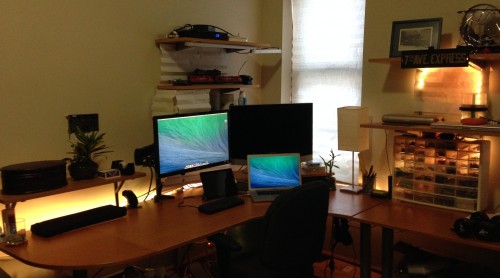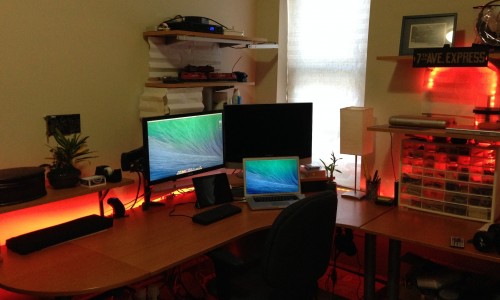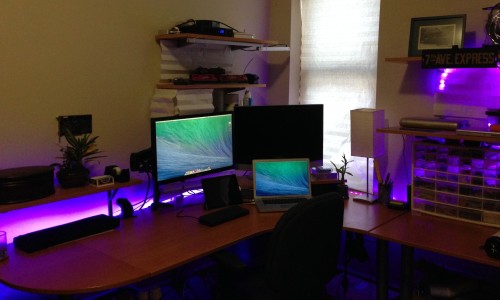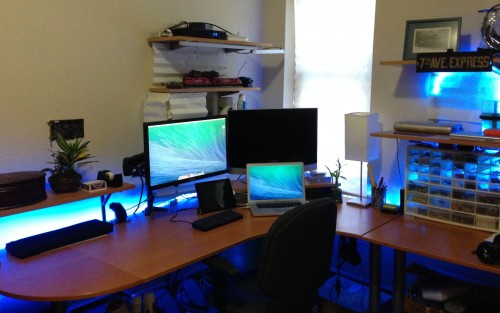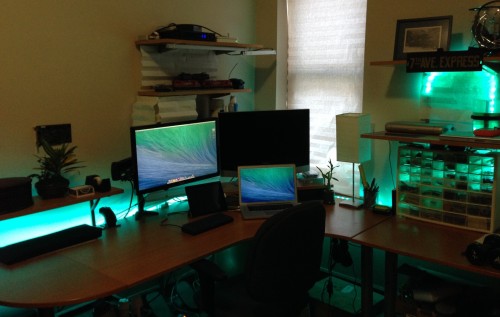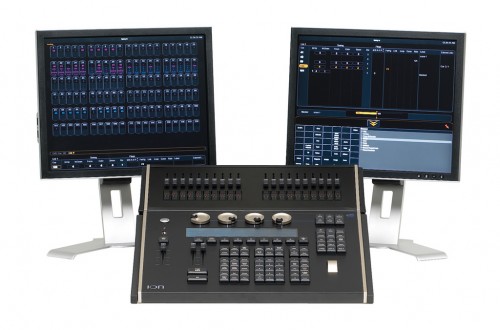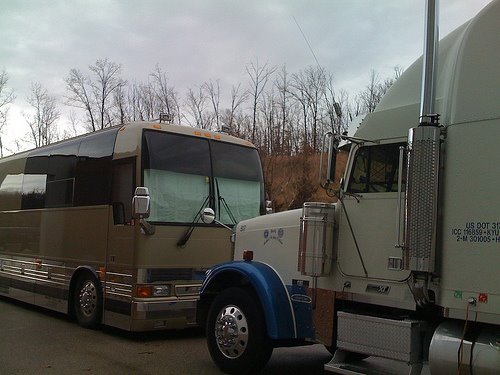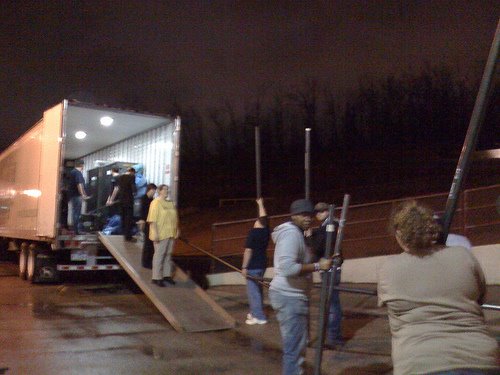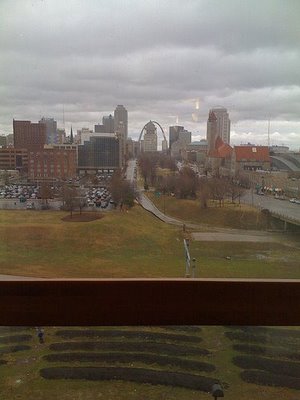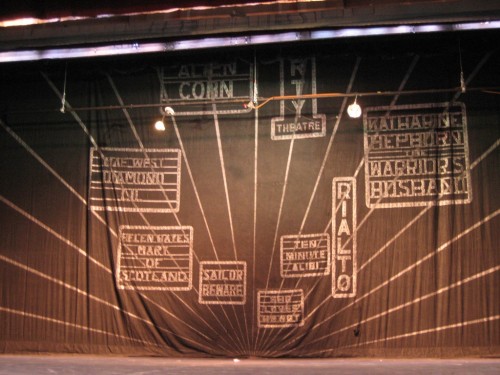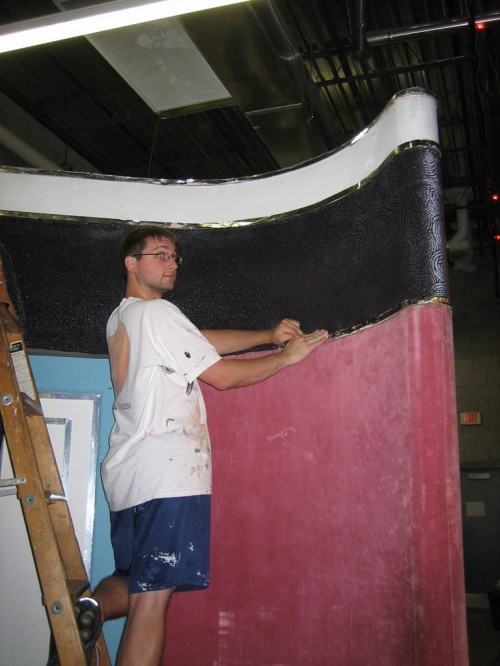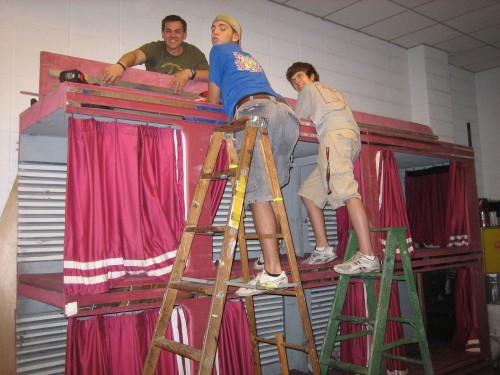We had a confetti drop at the end of Million Dollar Quartet. The process for activating the confetti had about as many safeguards as launching a nuclear weapon. This post is about how we did it and why.
Conveniently, the primary publicity photo for the show shows the exact moment when I called the cue:
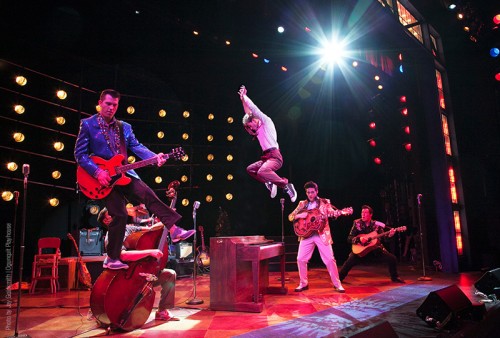
It’s on the button of the show, Jerry Lee hits the floor just as the confetti triggers.
The first rule of confetti (and snow) is you pick a spot in the show to do it where it won’t create a hazard for the rest of the performance. In our show, there was only a split-second where the confetti would be both not-dangerous, and not-too-late-to-be-effective: the moment he lands on the floor. So that was a short discussion at the production meeting.
The second rule of confetti (and snow) is you don’t trigger it when you don’t mean to. Having the drop boxes (or snow machines) as a channel on the light board, it’s pretty easy to do that if you don’t take any precautions. A careless channel check, or bringing up “everything” could stray into the channel number assigned to the drop boxes, and then you have a mess on the floor, and the deck crew is pissed, and the electrics crew is also pissed, because they have to reload. And then the deck crew is pissed at the electricians for complaining about having to reload, when reloading isn’t as annoying as sweeping (or mopping). So you see where this is going.
The other issue of course, is if the confetti somehow gets triggered during a performance, you have a real disaster because there’s now slippery mylar all over the stage for the rest of the show, or until someone can sweep it up.
On Sister Act we had the exact same confetti drop, so when it was added to MDQ I was very familiar with the procedure. But because of the extreme physicality of the end of the show, the 1-second window between when it would be a huge safety hazard, and where the cue goes, and the fact that there’s no real way for the actors to be “careful” about the staging and choreography should the floor and/or piano be slippery, I was concerned more than usual with making sure the drop can’t happen early.
For Sister Act there was a submaster on the light board that inhibited the confetti until two cues prior to the drop (there’s also a way to program the uninhibit right into the cue, but then if you were checking the cues for some reason other than in performance, it would trigger).
Technical Mumbo-Jumbo
The situation on MDQ was complicated by the potential chaos unleashed by the previous cues. Let’s take a look:
| Cue | What it Does |
| 339 | Bump blinding light wall |
| 340 | Bump blinding light wall (1 second later) |
| 341 | Bump blinding light wall (1 second later) |
| 342 | Different pattern on light wall (1 second later) |
| 343 | Shit goes crazy |
| “Arm the confetti” | |
| 344 | Button, Confetti Drop |
Working backwards from the drop (344), the previous cue (343) is about 5 seconds prior, while Nat plays a few glisses on the piano with his foot, like you do. It’s during this time that I’d say “Arm the confetti.”
The real challenge of this situation is in the cues prior to 343. 339 through 342 are on successive words: WHOLE. LOTTA. SHAKIN. GOIN on. While I was feeling comfortable with it by the end of the first week, the odds of coming out of the sequence in the right cue are far lower than normal, and there’s almost no time to correct it.
I was given a lovely gift on Sister Act of a tablet mounted above the calling desk that shows the cue display from the light board. So theoretically I can glance up after 442 and make sure 443 is next, and this was helpful in the first couple days where I struggled with that sequence. But I know from experience that due to wifi issues, VNC issues, “update your Windows software” popup issues, and whatever else, sometimes I lose the ability to see the cues. There’s basically no time between 342 and 343 where it would be comfortable for me and/or the board op to be 1000% sure we’re in the right cue before arming the confetti. So the confetti drop had to have a safety built in for the possibility that we could land in 343, and when I called 343, 344 would be taken instead.
Now the inhibit fader would protect against the confetti triggering if 344 was taken in place of 343. But what happens when we’re sitting in 344, thinking it’s 343, and I say “arm the confetti” and the fader is brought up? The confetti would trigger as soon as the fader goes up, still about 3 seconds early, creating a dangerous situation just as Nat is about to jump. With more time all of this could be carefully verified, but you have to understand that the six cues, plus manually arming the confetti, happen in 10 seconds. So I challenged our programmer to create a method of cueing the confetti that accounted for the fact that we might not be in the right cue, and in the event of an error, would fail safe.
It became something of a group discussion among the lighting-minded, and here’s what we came up with:
1. A submaster inhibits the confetti box channel so it can’t ever be triggered unless the fader is manually put up.
2. The channel that unlocks the confetti boxes is on in cue 344. But only in the first second of 344, and then it’s turned off with a follow.
This means the only way to drop the confetti is if the inhibit sub is up at the moment 344 is taken. If 344 was taken early (in place of 343, or earlier), by the time I said “arm the confetti” and the fader is put up, the 1-second window of opportunity would have passed, and the confetti will never fall.
With this system there is only one small span of time in which human error could cause the confetti to fall early: if between 343 and 344, after the confetti is armed, 344 got taken early. This window is only about 2 or 3 seconds, and the only way it could happen is if I called it early, or the operator had some kind of hand spasm. That kind of human error is unlikely when you know how important the cue is, and at that point no amount of programming can prevent it.
What I did to mitigate it was
(1) I didn’t say “go” with “arm the confetti,” it’s just an instruction that’s taken immediately. This avoids the association in the op’s mind that “go” means push the button.
(2) I said “arm the confetti” at the last possible moment that gave me time to cleanly say “344” before Nat jumps (the “go” for 344 was while he’s in the air, basically right where the photo is taken, assuming he’s on his descent there).
I’m pleased to say we never had an accidental confetti discharge. The drop worked every night, except once when the channel was left captured off from preshow work. But other than that, the show was run by two different board ops, and we never experienced an error related to the programming of the cue, or what the op had to do to activate it. I highly recommend this strategy if you’re ever faced with a momentary cue that you absolutely, positively do not want triggered by accident.



